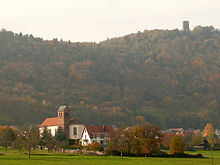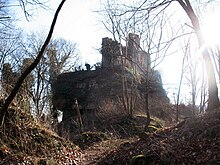Haegen
| Haegen | ||
|---|---|---|

|
|
|
| region | Grand Est | |
| Department | Bas-Rhin | |
| Arrondissement | Saverne | |
| Canton | Saverne | |
| Community association | Pays de Saverne | |
| Coordinates | 48 ° 43 ' N , 7 ° 20' E | |
| height | 195-587 m | |
| surface | 20.32 km 2 | |
| Residents | 677 (January 1, 2017) | |
| Population density | 33 inhabitants / km 2 | |
| Post Code | 67700 | |
| INSEE code | 67179 | |
Haegen ( German : Hagen ) is a French commune with 677 inhabitants (as of January 1, 2017) in the Bas-Rhin department in the Grand Est region (until 2015 Alsace ). It belongs to the Arrondissement of Saverne and the Canton of Saverne .
The neighboring communities are Saverne and Gottenhouse in the northeast and Thal-Marmoutier and Reinhardsmunster in the southeast. In the west, Haegen borders the Lorraine region .
Haegen is also one of the border towns of the Alemannic dialect area .
history
Place of pilgrimage
The village of Haegen remains to this day a place of pilgrimage dedicated to St. Quirinus von Neuss near a healing spring. The church there is originally a St. Matthew's Church with an oratory dedicated to St. Quirinus , where a statue of the saint stands for the purpose of pilgrimage. In documents from the 12th century, the parish church was known as the Quirinus Church .
Prehistory and geopolitical factors
Haegen hung in the secular from the diocese of Metz and in the clergy from the Abbey of Maursmünster (Marmoutier in French) under the care of the Strasbourg bishop . The origin of the Haegen Saint Quirinus pilgrimage is a legendary event, which the small village with the story of the two powerful dioceses of Metz and Strasbourg, the election of Pope by Leo IX. and the place of pilgrimage in Neuss .
After several devastating fires or sieges, the Maursmünster Abbey and especially the abbey church had to be rebuilt in 828 on behalf of Bishop Drogo von Metz . When the church was consecrated, the church was placed under the command of Saints Coelestis and Auctor , the second and thirteenth bishops of Metz, and given their relics.
The Maursmünster Abbey owned many small territories on both sides of the Lower Vosges peaks as ancestral fiefs or as a result of gifts from secular lords. This included the extremely forested land with the hermitage "Godelsadis" between the source rivers of the Saar (the red and white Saar) in the north of the Donon massif in the county of Dagsburg , which was donated to the Alsatian abbey in 966 by Count Ludwig von Dagsburg. 1049 came Gepa, the sister of Pope Leo IX. , back from Rome, where she had attended her brother's coronation. Leo IX had entrusted her with the relics of the tribune and martyr Saint Quirinus so that she could keep them in her monastery in Neuss. The mule that was carrying the relics stopped in one place and did not want to go any further. A Quirinus chapel was built there and the hamlet of Godelsadis was named Saint-Quirin . The body of the saint stayed in the Dagsburg region, while Gepa moved on to Neuss alone with the head of the martyr in order to establish the pilgrimage and the relic procession there since the 11th century. She left a nun in the Saint-Quirin Priory so they could look after the relics. After her death, the Abbey of Maursmünster sent a monk to the priory, but the low mountain range, deep in the forest, deterred him from staying longer at this pilgrimage site, which is difficult to reach from Alsace, without regular care. He left the priory with the relics and returned to Maursmünter. When epidemics and epidemics broke out, the locals believed this was due to the loss of the relics. They turned to the Count of Dagsburg, who decided to donate the priory to make the life of the brothers responsible for the administration of the pilgrimage easier. This was done on the condition that the relics would return to Saint-Quirin.
Origin of the pilgrimage in Haegen
The abbot of Maursmünster admitted that the relics of Quirinus did not have to stay in the abbey church, because they might put the local veneration of Saints Coelestis and Auctor in the background. It was then decided to keep the Quirinus relics in the parish church of Haegen. But when the Count of Dagsburg undertook to better organize and financially support the pilgrimage site of Saint-Quirin, the abbot agreed to allow the holy remains to be returned to Saint-Quirin. During the official relic translation ceremony , a spring erupted from the place where the shrine was placed. This miracle gave rise to a pilgrimage in the context of the healing spring. An oratory was built over the spring and an altar was placed in the parish church. There is a statue of the saint in both buildings. On the Quirinus Memorial Day, more and more pilgrims came to Haegen from the Upper Rhine area (Rhineland, Baden, Alsace, East Lorraine). There is no written evidence as to whether Haegen received part of the relics or whether the pilgrimage was limited to the miraculous source. On the other hand, it is certain that the parish church received the second phalanx of the thumb in 1782 through the donation of the Maursmünster Benedictine and pastor of Saint-Quirin, Dom Edmond Herb .
Quirinus belongs to the thaumaturges and was supposed to cure scrofula in particular , but also the plague and other forms of tumor. It remains unclear whether there is a mix-up with the Quirinus from Tegernsee. The latter alone should be able to heal the scrofulae. The miracle perpetrator Quirinus von Neuss was also known for protecting horses.
Geroldseck castles
In the district of Haegen there are two medieval castles, today ruins :
- Groß-Geroldseck ( French : Château du Grand-Geroldseck ) from the 12th century and
- Klein-Geroldseck (French: Château du Petit-Geroldseck ) from the 14th century.
Both castles were built to protect the Mark of Maursmünster with its imperial abbey. The lords of Geroldseck initially served as bailiffs and monasteries on behalf of the local sovereign, the bishop of Metz . The rule of Geroldseck, called "im Wasischen" to distinguish it from the Hohengeroldseck family branch in the Black Forest , consisted of thirteen villages or hamlets and the two castles mentioned, where the various family members stayed. The small nobility of Geroldseck died out at the end of the 14th century when Simon I died without male descendants. From the various branches, Johann von Geroldseck should be mentioned, who acquired the rule of Steinzel (today Niederstinzel in the Moselle department ). The castle ruins there are also called Geroldseck or Geroldseck-sur-Sarre. The rule of Geroldseck came into the hands of successive Lower Saxon noble houses: Wangen, Rappoltstein , Landsberg.
middle Ages
The Geroldseck castles belonged to the Ochsenstein lordship . When the family of the von Ochsenstein extinct in the male line with Georg von Ochsenstein 1485, the inheritance came through his sister to the counts of Zweibrücken-Bitsch .
Before its final siege and the subsequent destruction, the Groß-Geroldseck castle housed robber barons who particularly raged against the Metz and Lorraine rulers.
Modern times
In 1570 there was another inheritance that brought the Geroldseck castles to the County of Hanau-Lichtenberg : Count Jakob von Zweibrücken-Bitsch (* 1510; † 1570) and his brother Simon V. Wecker , who died in 1540, each left only one daughter as heiress. Count Jakob's daughter, Margarethe (* 1540; † 1569), was married to Philipp V von Hanau-Lichtenberg (* 1541; † 1599). The inheritance resulting from this constellation also included the rule of Ochsenstein. In the administrative structure of the County of Hanau-Lichtenberg, the Geroldseck castles were added to the Westhofen office . Philipp V von Hanau-Lichtenberg immediately carried out the Reformation in the inherited areas , which, like the rest of his dominion, now became Lutheran .
With the reunion policy of France under King Louis XIV , the Westhofen office and the Geroldseck castles came under French sovereignty. In the 18th century they no longer belonged to the Westhofen office, which after the death of the last Hanau count, Johann Reinhard III. , 1736 fell to the son of his only daughter, Charlotte , the Hereditary Prince and later Landgrave Ludwig (IX) of Hessen-Darmstadt .
Population development
| 1962 | 1968 | 1975 | 1982 | 1990 | 1999 | 2006 | 2012 | 2017 |
|---|---|---|---|---|---|---|---|---|
| 493 | 502 | 512 | 511 | 569 | 627 | 636 | 657 | 677 |
literature
- Friedrich Knöpp: Territorial holdings of the County of Hanau-Lichtenberg in Hesse-Darmstadt . [typewritten] Darmstadt 1962. [Available in the Hessisches Staatsarchiv Darmstadt , signature: N 282/6].
- Alfred Matt: Bailliages, prévôté et fiefs ayant fait partie de la Seigneurie de Lichtenberg, du Comté de Hanau-Lichtenberg, du Landgraviat de Hesse-Darmstadt . In: Société d'Histoire et d'Archaeologie de Saverne et Environs (eds.): Cinquième centenaire de la création du Comté de Hanau-Lichtenberg 1480–1980 = Pays d'Alsace 111/112 (2, 3/1980), p 7-9.
- Le Patrimoine des Communes du Bas-Rhin . Flohic Editions, Volume 1, Charenton-le-Pont 1999, ISBN 2-84234-055-8 , pp. 640-645.
See also
Web links
Remarks
- ↑ To the pronunciation: The "e" in Haegen is an expansion e .
Individual evidence
- ↑ a b c d e f g Christelle Kalck, Le pèlerinage de Saint-Quirin à Haegen Histoire et légende , Pays d'Alsace, No. 206, pp. 3–9.
- ↑ Christelle Kalck, Les relations entre l'abbaye de Marmoutier et le prieuré lorrain de Saint-Quirin au XVIIIe siècle , Pays d'Alsace magazine, No. 200–201.
- ↑ Félix Sigrist, L'abbaye de Marmoutier , Vol. 1, SHASE (in German Association for History and Archeology of the District of Zabern), 2000, p. 102.
- ↑ Alphonse Wollbrett, Le culte de saint Quirin à Haegen, Art populaire d'Alsace, pp. 53–61.
- ↑ a b Louis Reau, Iconographie des saints , No. 3, Iconographie de l'art chrétien, Paris, 1959, p. 1131.
- ↑ Paul Stintzi, Châteaux et ruines d'Alsace, éditions Alsatia, Colmar-Paris, 1948, pp 129-130, image. Rothmuller.
- ↑ Knöpp, p. 17.
- ↑ Stintzi, p. 130 - An information board on site also mentions the period of the robber barons.
- ↑ Knöpp, p. 17; Matt, p. 9.
- ↑ Knöpp, p. 17.




